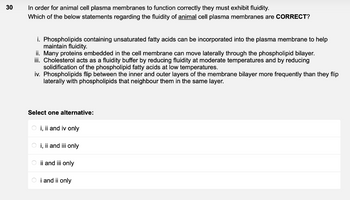
Human Anatomy & Physiology (11th Edition)
11th Edition
ISBN: 9780134580999
Author: Elaine N. Marieb, Katja N. Hoehn
Publisher: PEARSON
expand_more
expand_more
format_list_bulleted
Concept explainers
Question

Transcribed Image Text:30
In order for animal cell plasma membranes to function correctly they must exhibit fluidity.
Which of the below statements regarding the fluidity of animal cell plasma membranes are CORRECT?
i. Phospholipids containing unsaturated fatty acids can be incorporated into the plasma membrane to help
maintain fluidity.
ii. Many proteins embedded in the cell membrane can move laterally through the phospholipid bilayer.
iii. Cholesterol acts as a fluidity buffer by reducing fluidity at moderate temperatures and by reducing
solidification of the phospholipid fatty acids at low temperatures.
iv. Phospholipids flip between the inner and outer layers of the membrane bilayer more frequently than they flip
laterally with phospholipids that neighbour them in the same layer.
Select one alternative:
Oi, ii and iv only
Oi, ii and iii only
Oii and iii only
Oi and ii only
Expert Solution
This question has been solved!
Explore an expertly crafted, step-by-step solution for a thorough understanding of key concepts.
Step by stepSolved in 2 steps

Knowledge Booster
Learn more about
Need a deep-dive on the concept behind this application? Look no further. Learn more about this topic, biology and related others by exploring similar questions and additional content below.Similar questions
- How would increasing the amount of saturated phospholipid tails in the cell membrane affect the membranes flexibility? Explain your answer.arrow_forwardIn an experiment, a 0.001 (mole fraction) solution of polysaccharide in water is made and is placed in the compartment A. Compartment B is filled with pure water. The two compartments are separated by a porous semi-permeable membrane that allows the exchange of water molecules between the two compartments, but not that of the larger polysaccharide molecules. part 1: Show that the chemical potential of water in compartment A is lower than that in compartment B by 2.48 J/mol.arrow_forwardHEL 9. Consider the membrane protems in question 7. What cellular functions must always be performed by an integral membrane protein? Explain. NEL 2.2 Membrane Structure and Functioarrow_forward
- 9arrow_forwardOsmosis Water moving by diffusion across a membrane is called osmosis. Remember, diffusion is the movement of molecules from a high concentration to a lower concentration, in order to reach equilibrium. In the image below, the diamonds represent water and the circles represent solutes. Water will move by osmosis from the side with a higher concentration of water to a side with a lower concentration of water. In other words, water will move by osmosis from the side with a lower concentration of solute to the side with a higher concentration of solute. Water is attracted to solutes. 2. Use the following diagram to answer the questions below. Start by filling in the blanks for the missing % concentrations for beakers B and C. 150ml 100 Beaker A 0% Sugar 100% Water a) What is the solute concentration of: O Beaker A? O Beaker B? 150ml 100 Beaker B % Sugar 90% Water b) What is the solvent concentration of Beaker C? 150ml 100 Beaker C 40% Sugar % Water When we think about solutions in human…arrow_forward3. Please help answer this question, thank you so much!! :)arrow_forward
- Please explain the correct answerarrow_forward6. As a demonstration, an artificial cell consisting of an aqueous solution enclosed in a semi permeable membrane is placed into a beaker containing a different solution. The membrane is permeable to water and to monosaccharide's glucose and fructose but completely impermeable to the disaccharide sucrose. The concentration of each cell is described in the diagram below. 0.03M Sucrose 0.02M Glucose 0.01M Sucrose 0.01M Glucose 0.01M Fructose a. Which solute(s) will exhibit a net diffusion into the cell? Explain. b. Which solute(s) will exhibit a net diffusion out of the cell? Explain. C. Which solution is hypertonic, the cell or the solution? Explain.arrow_forwardA solution containing 3.58 x 1023 molecules/m3 of protein in water is separated from pure water by a membrane 3.20 μm thick. The diffusion coefficient of the protein through the membrane is 7.15 x 10-18 m2/s. On average, how many molecules cross 0.0240 μm2 of this membrane each second? [Answer as a positive number with 3 sig digits, but do not enter units with your answer]arrow_forward
arrow_back_ios
arrow_forward_ios
Recommended textbooks for you
 Human Anatomy & Physiology (11th Edition)BiologyISBN:9780134580999Author:Elaine N. Marieb, Katja N. HoehnPublisher:PEARSON
Human Anatomy & Physiology (11th Edition)BiologyISBN:9780134580999Author:Elaine N. Marieb, Katja N. HoehnPublisher:PEARSON Biology 2eBiologyISBN:9781947172517Author:Matthew Douglas, Jung Choi, Mary Ann ClarkPublisher:OpenStax
Biology 2eBiologyISBN:9781947172517Author:Matthew Douglas, Jung Choi, Mary Ann ClarkPublisher:OpenStax Anatomy & PhysiologyBiologyISBN:9781259398629Author:McKinley, Michael P., O'loughlin, Valerie Dean, Bidle, Theresa StouterPublisher:Mcgraw Hill Education,
Anatomy & PhysiologyBiologyISBN:9781259398629Author:McKinley, Michael P., O'loughlin, Valerie Dean, Bidle, Theresa StouterPublisher:Mcgraw Hill Education, Molecular Biology of the Cell (Sixth Edition)BiologyISBN:9780815344322Author:Bruce Alberts, Alexander D. Johnson, Julian Lewis, David Morgan, Martin Raff, Keith Roberts, Peter WalterPublisher:W. W. Norton & Company
Molecular Biology of the Cell (Sixth Edition)BiologyISBN:9780815344322Author:Bruce Alberts, Alexander D. Johnson, Julian Lewis, David Morgan, Martin Raff, Keith Roberts, Peter WalterPublisher:W. W. Norton & Company Laboratory Manual For Human Anatomy & PhysiologyBiologyISBN:9781260159363Author:Martin, Terry R., Prentice-craver, CynthiaPublisher:McGraw-Hill Publishing Co.
Laboratory Manual For Human Anatomy & PhysiologyBiologyISBN:9781260159363Author:Martin, Terry R., Prentice-craver, CynthiaPublisher:McGraw-Hill Publishing Co. Inquiry Into Life (16th Edition)BiologyISBN:9781260231700Author:Sylvia S. Mader, Michael WindelspechtPublisher:McGraw Hill Education
Inquiry Into Life (16th Edition)BiologyISBN:9781260231700Author:Sylvia S. Mader, Michael WindelspechtPublisher:McGraw Hill Education

Human Anatomy & Physiology (11th Edition)
Biology
ISBN:9780134580999
Author:Elaine N. Marieb, Katja N. Hoehn
Publisher:PEARSON

Biology 2e
Biology
ISBN:9781947172517
Author:Matthew Douglas, Jung Choi, Mary Ann Clark
Publisher:OpenStax

Anatomy & Physiology
Biology
ISBN:9781259398629
Author:McKinley, Michael P., O'loughlin, Valerie Dean, Bidle, Theresa Stouter
Publisher:Mcgraw Hill Education,

Molecular Biology of the Cell (Sixth Edition)
Biology
ISBN:9780815344322
Author:Bruce Alberts, Alexander D. Johnson, Julian Lewis, David Morgan, Martin Raff, Keith Roberts, Peter Walter
Publisher:W. W. Norton & Company

Laboratory Manual For Human Anatomy & Physiology
Biology
ISBN:9781260159363
Author:Martin, Terry R., Prentice-craver, Cynthia
Publisher:McGraw-Hill Publishing Co.

Inquiry Into Life (16th Edition)
Biology
ISBN:9781260231700
Author:Sylvia S. Mader, Michael Windelspecht
Publisher:McGraw Hill Education